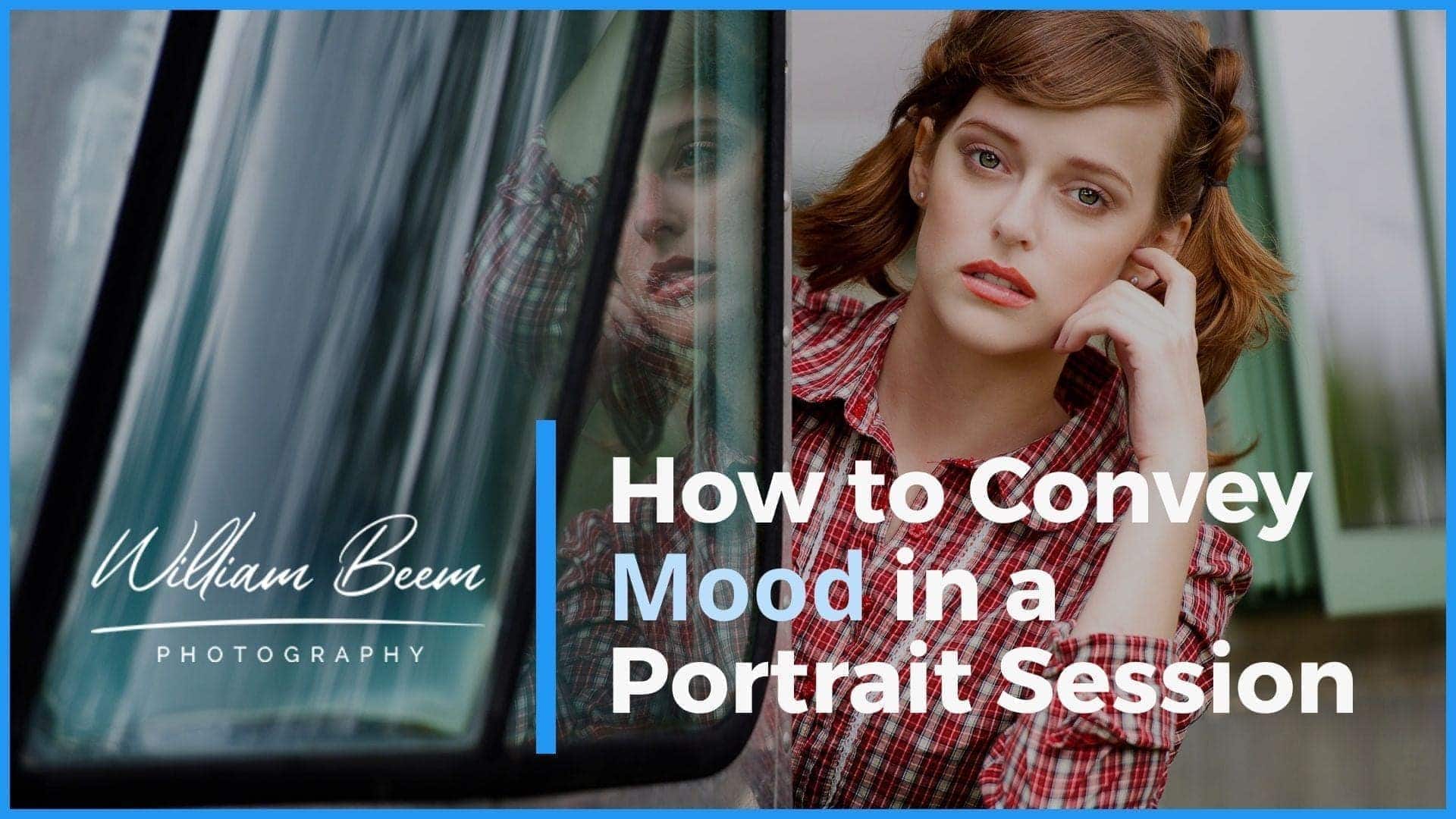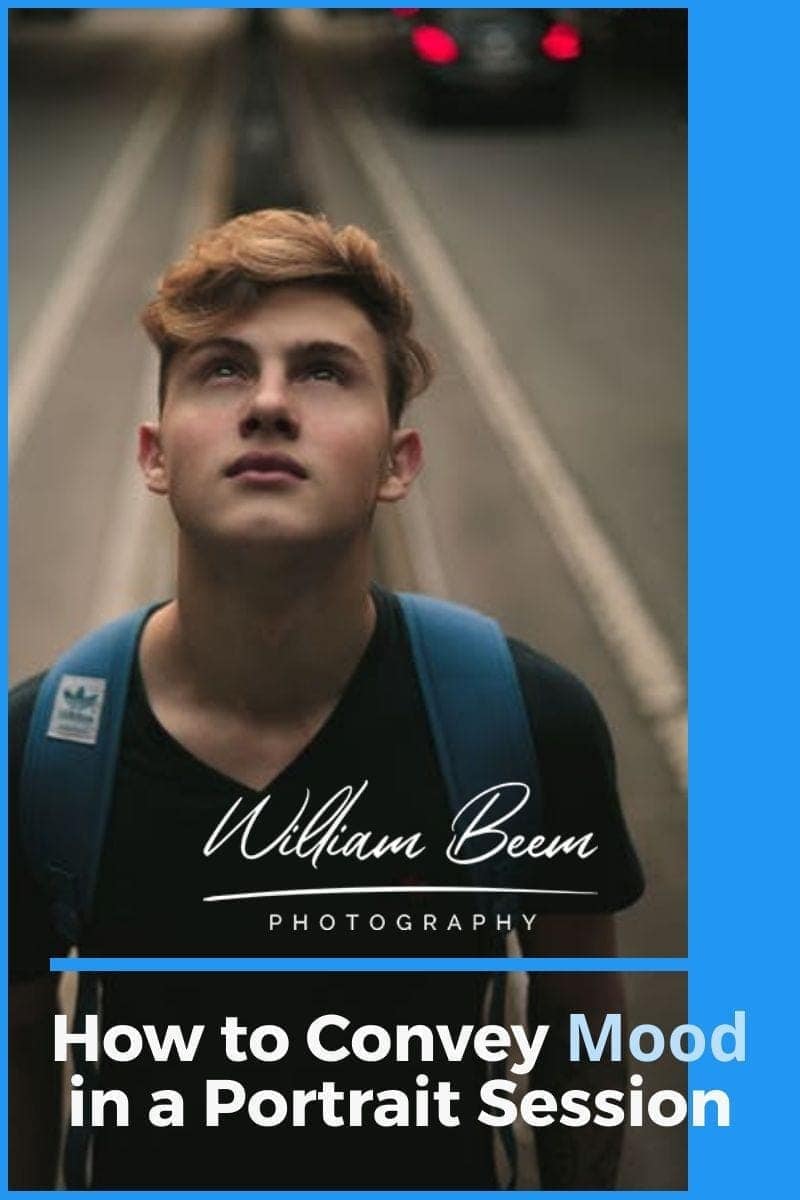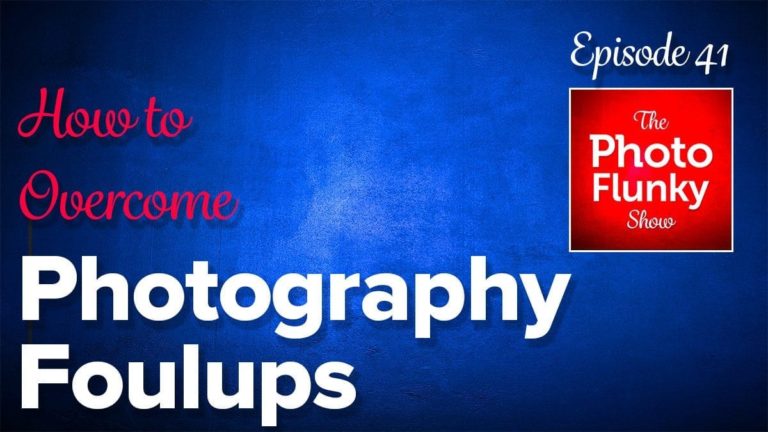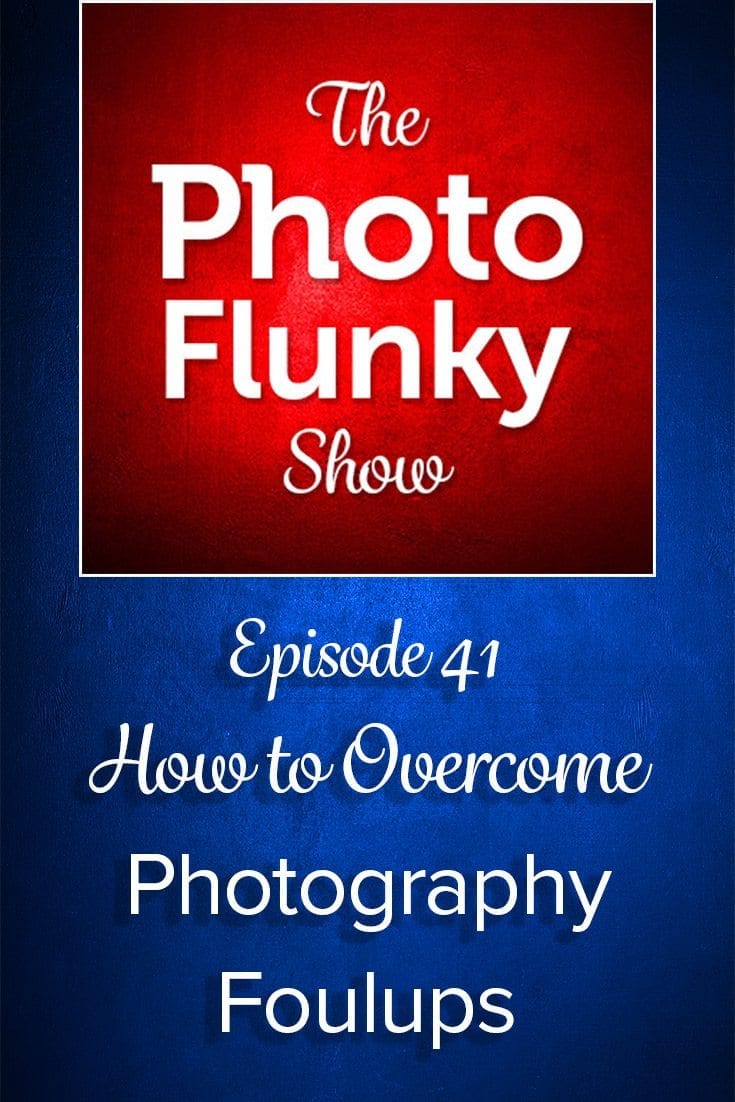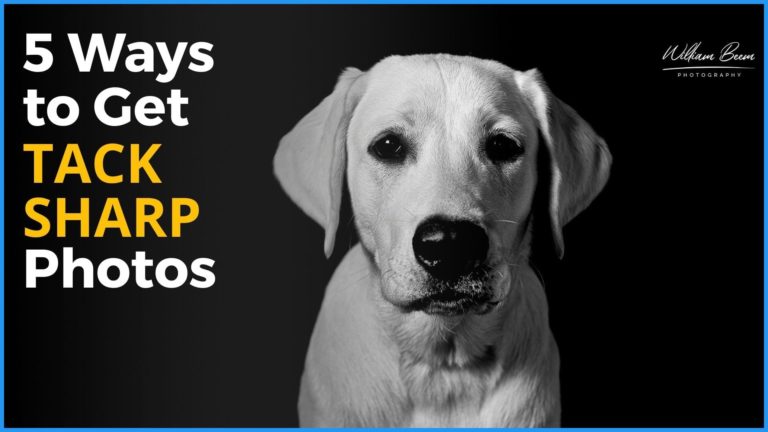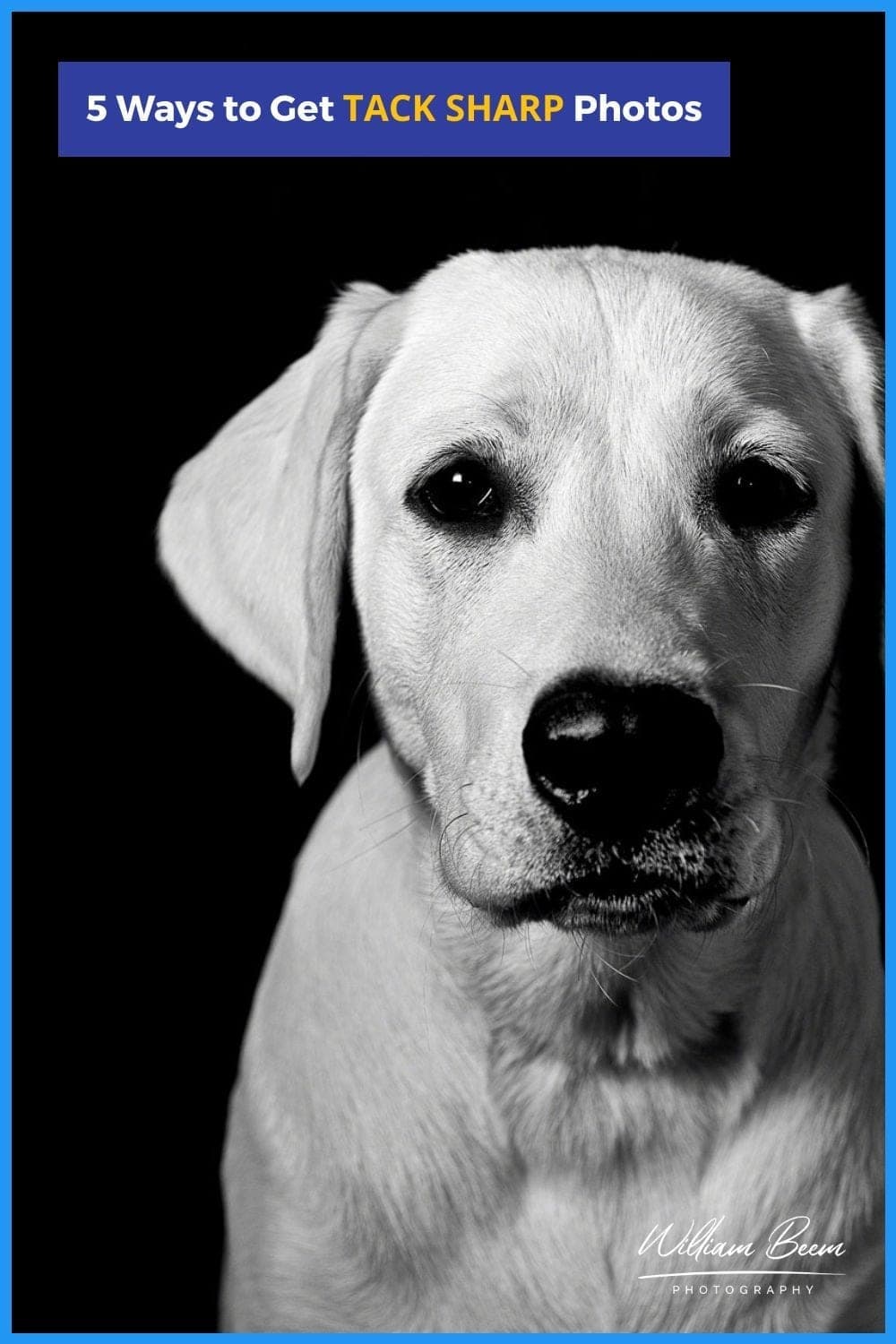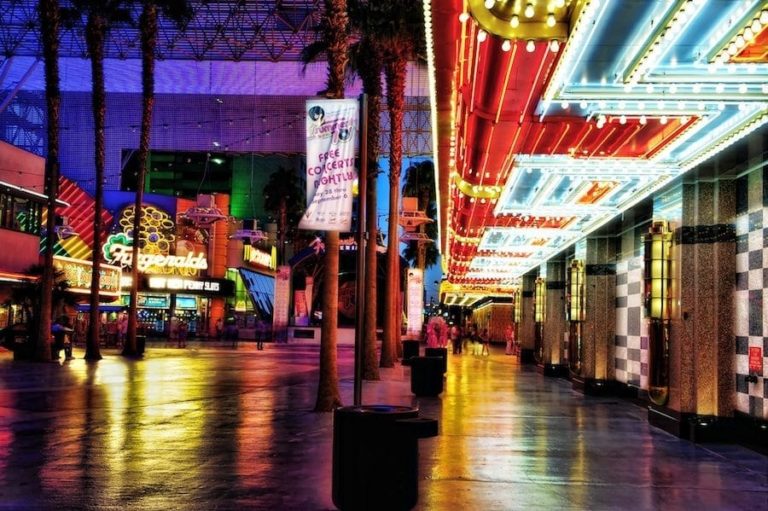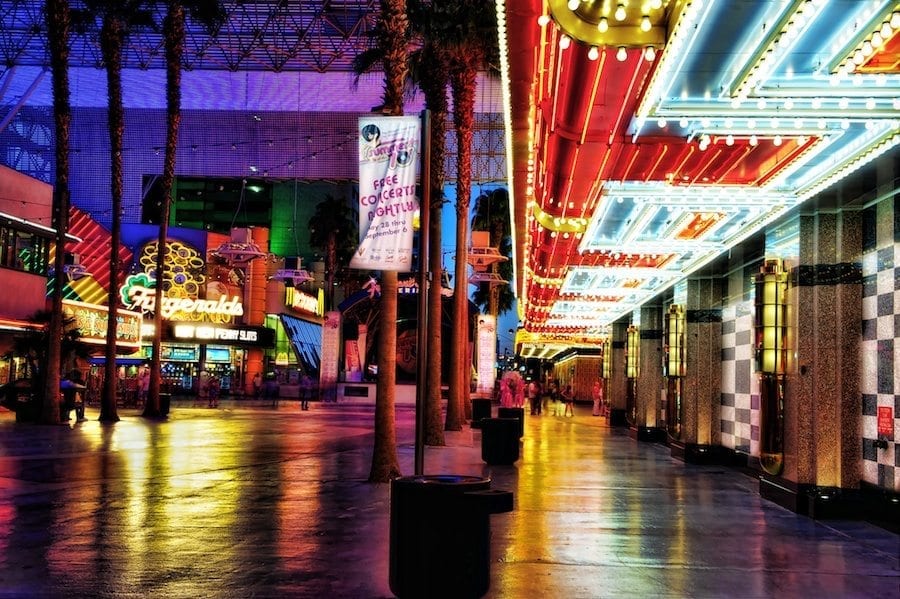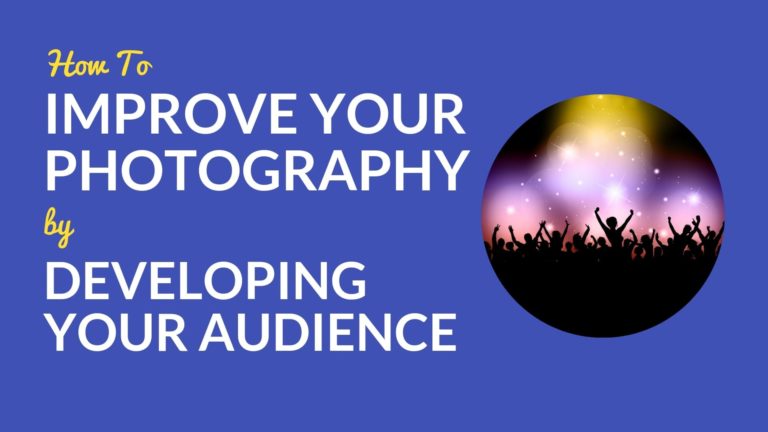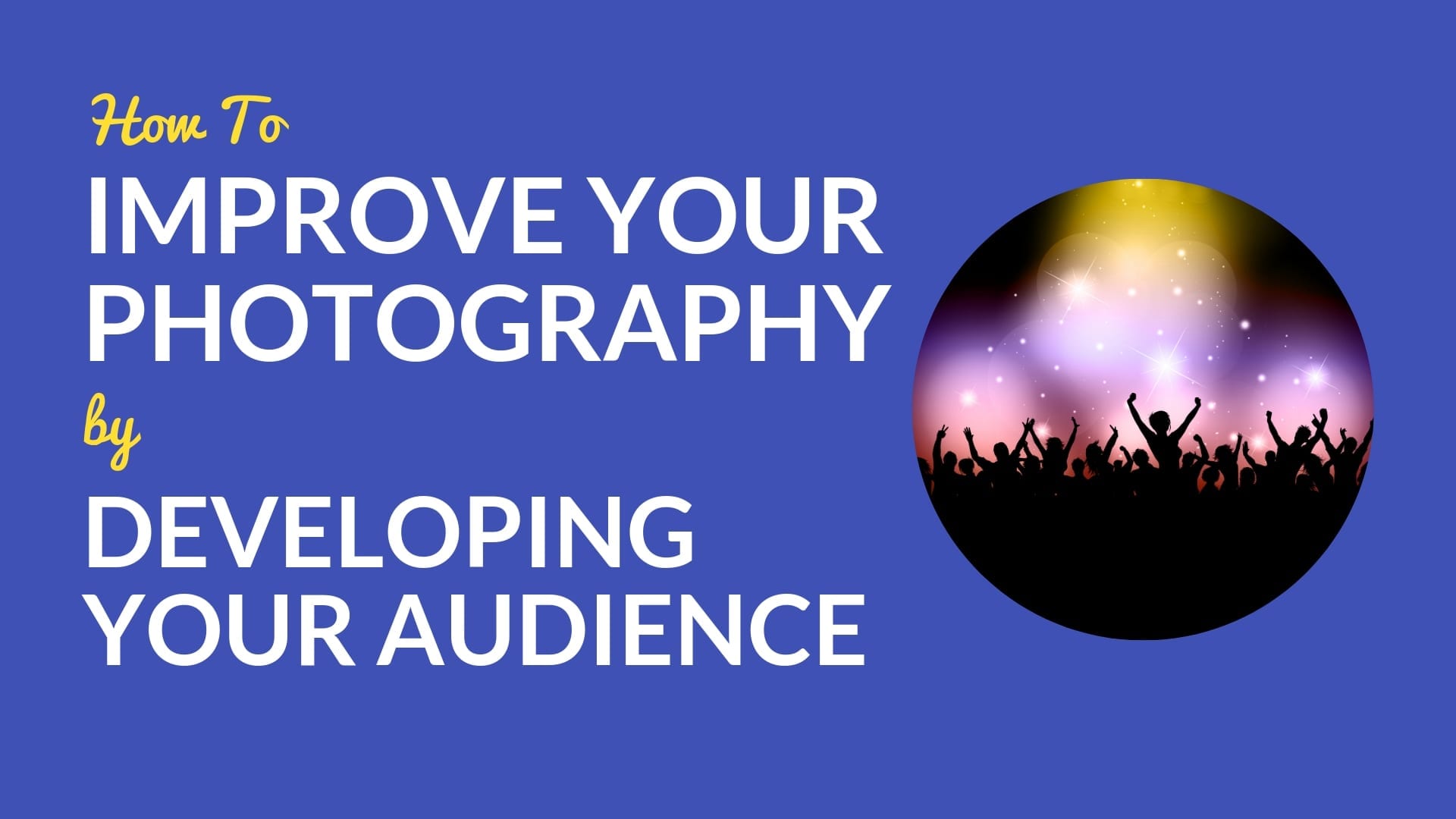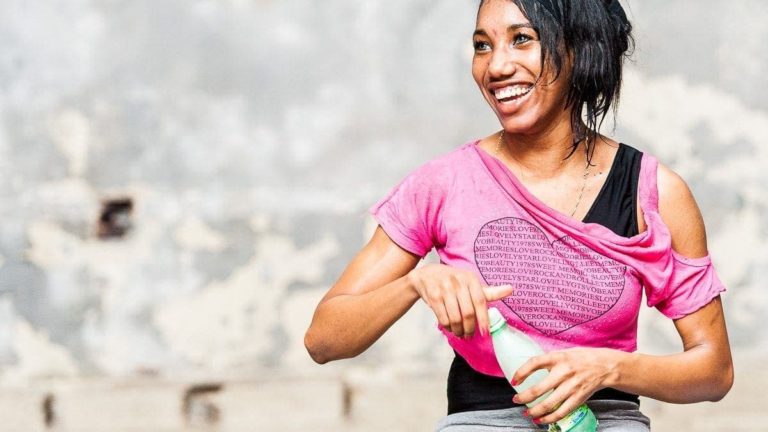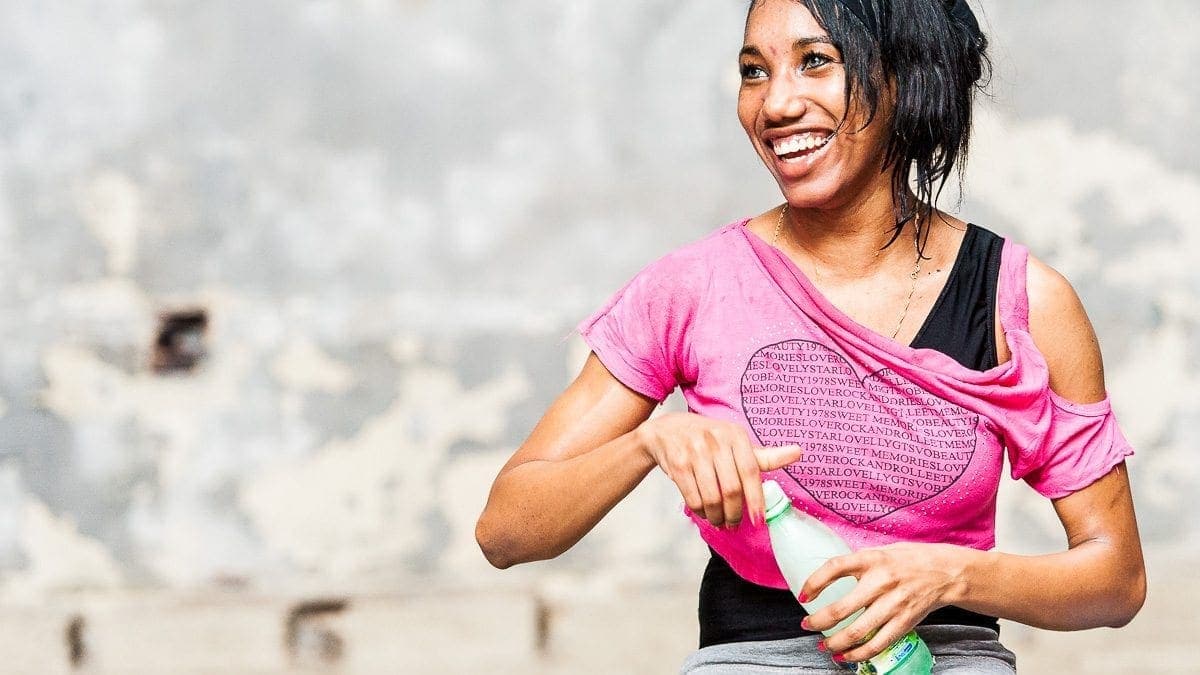Affiliate Disclosure: We earn a commission if you purchase through one of our links at no additional cost to you.
Creating a mood in a portrait doesn’t have to be hard. We discuss a bunch of factors you can use, either alone or in combination, to convey a mood.
Why is a mood important in a portrait? It enhances the viewer’s experience with your portrait. The idea is to connect with an emotional response and reaction from your viewer. The mood affects how your viewer relates to your subject.
Think about two different television series of people on a deserted island: Gilligan’s Island and Lost. Same premise, but different moods. That’s the power of conveying a mood in your portrait.
Mood in a Portrait from Several Factors
Conveying mood is a a big part of storytelling. In effect, mood is how you get the viewer to feel something about your photo and for your portrait subject.
Start with the idea of your story and how you want to make the viewer feel. Is that feeling positive or negative? What mood would support the emotion that you want the viewer to feel? Now, start thinking about the things you can use in your portrait to establish the right mood.
There are plenty of ways to create a mood. Here are 8 factors that we discuss in this episode.
- Expression
- Gesture
- Color
- Light & Shadow
- Atmosphere
- Environment
- Texture
- Styling
You could also use Theme to set your mood. Stories often have themes, such as Love, Effects of Power, the Circle of Life and others. Think about some of your favorite books or movies and notice how the stories use theme to make a point or establish an emotion. Those same themes can work in your portraits.
Time Stamps
Before we get started. I just want to let you know that Lee is in her chair. She's looking at me and she's moving her hands around. Like, are you going to get started or not? Because I hit the recording button and you know what? I just wasn't in the mood to start talking. And that's kind of what we're going to be talking about today is why mood matters in your portraits.
I'm William Beem welcome to, I Like Your Picture. The show that helps you improve your photography with visual storytelling. What is visual storytelling? It's a method of approaching your photography with a knowledge of who you're trying to serve with your photos and what emotion you want to make them feel. We encourage you to concentrate on your subject, light and background to create a photo
your audience loves. I'm glad you found us. Hi, this is William Beem. Lee. What kind of mood are you in today? She's in a happy mood. You know why you're in a happy mood? Um, cause it's just a good day to be happy. All right, that works for me. Hey, we're going to be talking about mood today and specifically how to use mood and how to convey a mood in your portrait session.
So we're going to be talking about what is a mood and why it matters. And then more specifically, we're going to talk about what factors affect the mood in your photos. So Lee, I'm always love to pick on you first because I've been talking about. I spend most of the time talking upfront and then I need to let, give you a chance to speak.
So why does mood matter in a portrait? It sets the stage for the emotion and you always want to get some kind of, it's not, I mean, emotion sounds like a big word to apply to a photo, or it really comes down to a feeling you want photos to make somebody feel something. And that's something we've always said is that, you know,
every photo ought to evoke some kind of emotion from the people who are looking at it. Mood is one of the ways that you do that and mood really breaks down. Yeah, you're feeling good or you're not feeling not so good. You know, is it a positive or a negative experience that you're showing neither one is necessarily right or wrong, but it depends on who is your audience and what do they want to feel?
And sometimes, you know, they want to feel happy, go lucky they want something joyful and uplifting other times, maybe not. Maybe they do need to feel something a little bit different. The thing the mood leads you into the emotions and various emotions for a certain type of mood will branch off of that. And not everyone's going to feel the same emotion,
but the mood is, um, a little more stable. And some of my own portraits, I know I've looked for different moods. Some of, most of them are, I would say probably positive. That kind of leads people to have, you know, nice big smiles or a subtle smile. But sometimes the mood that you're looking for is different. Like,
so for example, if I want to show a portrait of, I've got one, a portrait of a woman who's longing for someone else to come along, you know, waiting for, uh, a husband or boyfriend to come along in that mood is, you know, not quite so joyous and happy. There's a different feeling or sentiment going on and you kind of pick up what that person is feeling by the mood that set in the photo.
And there's a number of factors that kind of influenced that mood. And those are the, some of the things that we're going to be going over today. We're talking about portraits. Let's start off with expression. When you look at someone's expression, Lee, I mean, did you get an indication of their mood? Yeah, pretty much. I mean, do you do that in real life?
You do that in a photo. I think in a photo is almost more powerful because it's frozen in time. You know, you see somebody and you walk by them and they smile. Maybe you missed the first half of the smile or maybe you don't see it at all and they don't look threatening, but you kind of miss that. In a portrait. You cannot get away from it.
It is, that expression is there and it doesn't change. And that's one of the things that we look for in portraits, whether the we're shooting ourselves before looking at someone else's portraits, and yes, we are looking at your portraits. We're constantly critiquing and not necessarily to pick on people, who've taken portraits, but to learn things for ourselves of what we like and what we dislike about portraits that we're going to be taking.
And expression is one of the key factors that we've found that really set the mood and what the emotion is going to be for that portrait. Yeah. You're not the worst expression is? A dead fish. Yeah. When there isn't one, We've noticed this, and this is particularly with a lot of amateur model photography and I'm not blaming the model or the photographer because portraits are a collaboration.
But there seems to be this tendency to have just kind of like a blank, Dead fish expression. Well, when there's no expression and there's no feeling, the photo suddenly stops being about emotion becomes all about technicality. So in my mind, once there's no feeling in it, if I'm going to hover around and spend time looking at that photo, I'm going to start noticing more technical things that I probably would have not even worried about.
It depends upon the genre of the type of portrait when we see something like that is typically in what people are trying for, what I would call glamour photography. It's not about, you know, a lifestyle where you see a family or a couple or something, having a good time or doing whatever they're doing. It's not about the clothes or the fashion. It is specifically a portrait about the model and the subject.
And for some reason, they're looking at other things, I guess, other than the expression. Yes. I mean, I'm trying to put that in a nice way. We see a lot of the young women who are posing and they're looking for angles, they're looking for gestures, but their expression just seems to be empty or blank. And I don't really know why that is a trend.
Yeah. I still remember going with you one day, there was a, some kind of group meet her footage, shoot going on somewhere. I forget what it was and kind of doesn't matter. But I remember while you were talking to somebody, I looked over and there was a photographer, had a model and they had a really nice rapport going on.
She was laughing. She had this beautiful smile. She just looked so relaxed and natural. He had a nice, you know, he was engaging nicely with her and he picked up his camera. And as soon as he did that, she lost all expression on her face. She got this almost sullen look at our hands, just went from being relaxed.
They kind of came up on her face and turned into these claw things. She just tensed up soon as the photo thing started, I thought maybe he should have been shooting without his eye on the lens, like with a shutter release or something. Well, she didn't know she had, because I looked at what happened? That's actually the kind of technique that I like to use these days is I want to set the camera on a tripod.
I want to look at the eyes of my subject. I want to engage with that person, male or female. It doesn't matter which one. And you know, if we're know that we're not going to be moving around, well, let me sit on my composition. I'll put the camera on a tripod with a shutter release. And it's easier for me to see what's going on when the right moment is to capture
something when we're engaging with each other, rather than I'm hiding behind my camera, looking through the lens. Well, here's the thought, it's just a question. Would you say that maybe models who have less experience and haven't had the opportunity to, to learn all this because these things take time to learn and to understand, would you say that maybe they feel like they're engaging with the camera rather than with a person behind the camera?
And because they're engaging with an inanimate object, same thing happens to their expression. If you put a human face there, it might change? Exactly true because I've seen this happen time. And again, as, as the example you just gave, the thing that we went to was the local meet and greet. There's the community around here that meets quarterly and models,
photographers, hair, and makeup artists, basically people who are interested in portrait photography come out and they network and they do some photography. I hear photographers from looking through their viewfinder. They tell the model, imagine, you know, whenever you're talking to your boyfriend or imagine this, and they're trying to get them to use their imagination rather than think about the fact that they're looking through a piece of glass and plastic.
And that's why I've come to really like shooting on a tripod. Now then I can stand up. I can look and make eye contact, and I have a much more natural engagement with my subject. And in turn, they have a much more natural engagement with me. I already know that everything's set. I don't have to worry about focusing. I don't have to worry about my exposure.
I've already got all that nailed down. All I gotta do now is engage with my subject and click the shutter when it's the right time. That works. I think in my mind to get some of the best expressions now with me, I like to crack jokes. So usually I'm looking at more positive moods in those kinds of photos. If I know that I'm going to be working with someone and we're going to do something,
that's a bit more sedate, you know, not necessarily a happy, fun, lucky day kind of photo shoot, we're doing something that's a bit more sedate. I'm going to change my behavior and how I engage that model to get his or her expression to match the mood that I want to have in the photograph. So the next thing I wanted to bring up and we kind of discussed,
this was gesture. I think that his body language or the movements, you know, it's like is how is somebody holding their hands? What are they doing? Are they pulling something? Are they holding a prop? What kind of gestures are they making with their body? And again, this kind of goes back to, you've seen people who are happy and you've seen people who are not so happy.
They have different body language, shoulders as well. Are you slumped over? Do you have your head in your hands? Like you're sitting down and just kind of like, Oh, this is, this is the worst. And you know, maybe that's what you want. You know? And sometimes that's just casual, you know, someone's just sitting there with their head in their hands because it's comfortable.
It's like, what else am I going to do? I'm sitting here in a chair waiting for you to take a picture, and you're taking forever. But those gestures affect the mood as well. Think of them in terms, are they positive or negative? How is it going to impact the emotion that someone's going to get when they're looking at your photo?
And, and that's kind of what you're looking for, gesture. That's how you start thinking about how you're going to direct somebody. That's your subject. Is their expression and their gesture. That's, that's what they have to give. And they're looking for you to give them feedback on what they're doing, because people don't see themselves. I mean, most photographers don't set up mirrors,
so the subject can see themselves. And that's why models are, or subjects are always so excited to come around and look at the camera and say, what did you get? Cause they don't know, hoping for the best in the world. And one of the things that you really don't want is for you to be really excited. And then they look at us said,
Oh, don't shoot with this person ever. Okay. Another factor that influences mood is color. And you can think about this as far as cool colors versus warm colors. You know, it's like the cooler colors are probably going to go a little bit more towards the negative side. They don't have to, but that's something like if you're trying to set a mood.
You'll see this in movies all the time. When they want to set a mood, that's kind of creepy or sad or just pensive are often quieter color. Yeah. And you want to quiet down the set, you use cool colors, but if you want to brighten things up and you want to brighten up your mood, you're going to use brighter colors and thinking about this as far as bright versus muted,
I think you can kind of go around the color wheel, and take any color and make them either brighter or faded or muted. Yeah. But I still think of the warmth with the, you know, yellows and reds and oranges versus the cyans, blues and greens on the other side to kind of affect the mood. But that's something that you can play with is what is the color of this?
You've got an, and that color could be anything from your background, your wardrobe, even your lighting. If you're working with gels or you got some kind of reflection, all of that color and how it fits on your scene is going to affect the mood. All right. Our next item up is light and shadow. And Lee, I want to throw this to you again,
because we've talked about this a number of times, but not necessarily in terms of mood. When you're doing your flat lay stuff, you're very careful and cautious about how you use your lighting. And are you trying to set a specific mood for those photos? Yeah, I am. I don't. I start by, you know, with the Light kind of pretty much,
I guess, falling from the side evenly over everything. And then the next thing I do is I block off almost all the lights, like basically around all sides and maybe a little from above as well. And then I start to open up to let it and where I went. Um, there, there are two things I'm looking for. I want light to fall on the things that I went to be the main part of my subject.
Also what it to kind of move in in some kind of direction, in a very consistent direction, over the most important part of a subject. So where it comes in, depends on how I've laid things out. And the other thing is that I want some shadows to give it cause with flat lay, you have to be very attentive to make sure you've got the,
that doesn't look very two dimensional. So the shadows are incredibly important. Um, I kind of want them to be very noticeable, but not harsh. I know when clean lines around my shadows. So those are the things I'm looking for with lights. So yep. The light and shadow is incredibly important. I start a little bit backwards by taking all the light out and then opening up where I went to go in.
And if you haven't listened to our podcast before, or you don't, I'm not quite sure what we're talking about. Lee takes photos of coffee and it's a flat lay, you know, top down view of her coffee mug, but she also decorates her scene and she'll use, you know, different flowers, different little spoons, or what is it, a little powders or stuff that you're putting in there.
I guess things that would go into coffee. Sugar. It's Brown?, It's Brown and Brown sugar in your coffee. All right. I'm not a coffee drinker anyways. You've got all those elements there, but then you've got to decide what is the mood and part of that I think is going to be the color of your background. And part of it is the way you allow light and shadow and where it falls. And what kind of mood are you drinking?
It is, this is like, you've said that this is the experience that you want people to feel. It's not about the coffee. It's about the experience of someone having like their first cup of coffee of the day. Yes it is. And I think that's one of the reasons why I don't want. Um, I, I don't want too much light on there.
It's not that I'm trying to create something moody as much as I'm looking for something, that's kind of, there's a sense of quiet and calm. I don't want anything to jump out and hit you over the head. I go for side lighting because early morning light comes in kind of low across the horizon. So it is from the side. So I'm trying to be true to that mood that,
you know, that feeling that I get in that time of having that early morning coffee. And that's what I find fascinating because I was talking about moves being positive or negative. And that's kind of like the textbook definition, but you're looking for a calm mood. That's not necessarily negative and it's not necessarily positive to me. It's not, but I can kind of tweak that with little details,
the positive or negative. I want that to be subtle because here's the thing. Um, when you have a mood, you spend time with somebody you're going to start pushing that mood on them, whether they like it or not. Um, even if you just provoke them to something by, you know, being heavy handed, I kind of realized that there's a lot of power in your mood when you start engaging with people.
So this is through a photograph. I want to make sure that there is some kind of emotion. So I want to set the tone for that. You know, when they're looking at my photos, but also to what a dominate it. I want them to go with, whatever is happening on their their day. So the dominant thing there is that kind of sense of peace and calm.
Maybe there's apprehension or anticipation warnings, you know, you've got the whole day ahead of you and some are good and some, you know, ahead of time are going to be a bit more challenging. So I guess for me, from my photo to be received by somebody or enjoyed by someone, I've got to take into consideration that I have no idea what their day's going to be like,
but this is about that kind of time to collect yourself in the morning. This is where I get a little piece of calm. Yeah. And that's what the light and shadow can really do for you. Think about a couple of other examples. If you wanted something that was a little bit of an undertone year and a half, probably a lot of shadow and darkness,
and then something's going to be emerging from that light. That can also be something that's very joyous as something does, you know, kind of, it's almost like it's being born out of the light or out of, out of the shadow into the light. And then you can have something that's very brightly lit and happy and joyous. The light and shadow makes an incredible difference.
I mean, the shadows obviously define the edges and, and where our subjects are. But I think the light, when you start looking at the characteristics, it's like, is it going to be a hard or soft? Cause you said that you don't want those hard shadow edges. You want a softer shadow, but you still want it to define the different things that are inside of your Yeah,
I do. And that, that those soft shadow edges may make sure that I'm being true to the time of day that I have it. Remember that it doesn't matter if you're shooting your photo at the time that you want people to, to kind of see the setting or relate to the setting. Um, light is different and depending on how you position things,
um, you could skew that sometimes you still need to work with it's depending on where you shooting. Well, you also mentioned that you want sidelight. So the direction of the light is very important, but also the quantity of light. In other words, it's not like some bright search beam coming in. The amount of light that's coming in as sidelight is kind of what you expect in the morning.
It's not like overwhelming. It's not like blinding you as soon as you got out of bed, it's like gradually coming up. Yeah. And typically it's, it's slightly on the warmer side. Not always, I mean, not always, sometimes I go for something a little cooler. And it's the same thing. When you're looking at portraits, as far as the mood that you want to set the light and shadow and how you're using that light can really affect the mood.
If you want to make someone look like a corpse, you go put some blue light on them. But I mean, even with my, you know, we were talking about flat lay photos, but even with my food photography, I think through the flat lay photos are really kind of settled more securely into a style of doing things. It wasn't really that different to what I was doing.
The way that I liked, or don't like things now, even with, you know, of course, one that I took a little while back muffins and coffee, so that wasn't a flat lay photo, but the whole thing set. And it was, you know, I controlled the lighting pretty much identical to what I did for the flat lay. It's just the angles that the light had to be different.
The composition and the setup was a little different because the dimensions of the photo were different. But were you able to keep the same kind of mood? I was able to keep the same kind of mood because I believe I actually did that. I did it as a flat lay, and then I did it as a 16 by nine. I think I did a square crop and I took separate photos for them because I had to recompose to make sure that I had my important elements.
And when you recompose, you often have to adjust your lighting and shadow your light source, new shadows as well for that crop. That was something also learning curve a few times for me. That's why it's, I think very good to do the same style repeatedly because you learn as you make subtle changes in the way that you're composing, then you may have to make subtle changes in the way your scene looks in the light and shadow work.
So, and then that's how you start to master things. It's like, okay, I know if I move this little thing an inch, I got to go back and change this other thing to compensate for it. And that's how you master something. Because if you keep jumping from one kind of photography to another, to another and always changing, then you really haven't mastered anything.
Yeah. Another element or a factor that influences mood is I'm going to call this atmosphere. And what I mean by that is, is there smoke dust, some kind of particulate matter in the atmosphere? Because if you're taking a photograph of somebody without anything at all in the atmospheres, you got a nice clean shot, but then maybe you see some smoke or some fog or haze,
does it change the way you want the person to have their expression or gesture? The atmosphere kind of makes things, they could look, make them look mystical. It could make them look dangerous. Even snow if you're taking something up North, because it does not snow here in Florida. But I've seen some beautiful portraits of people that are got like a,
their winter clothing on, they've got a hood over their head and the snow is falling down or falling at an angle. And that just really adds something to the storytelling and the mood that goes within that portrait. Well, the atmosphere also affects the kind of temperature and the photo. Yeah. Yeah. And that also, that kind of leads into the mood,
which then controls your, the range of emotions that may stem from it. Yeah, exactly. I'm in the same kind of atmosphere. And the next item we're going to talk about is environment. The same atmosphere in the same environment may have a different mood depending upon the expression. So for example, I said, I've seen some beautiful, wonderful people who are portraits are smiling in their happiness.
No, if you put me in that same environment, I would not be smiling. I am a Florida boy through and through. I do not do snow. If anytime I'm in snow, I fall on butt and it's just not a happy atmosphere for me. But that just shows how these factors kind of work together and influence the mood. Overall. Some people can be happy in snow.
Some people can be miserable in snow. Well, I've been happy in snow. I've also been walking along and have to take a detour because some, you know, some places closed and I'd been walking. When that snow is, you know, above knee deep. And you've got knee-high snow boots on, that snow starts falling in down through the top of it.
You keep walking in that you end up with, you know, on the, on the verge, there's a frostbite with wet feet. What started out as a great walk and the crispy snow is not so cool anymore. Talking about environment a little bit. You know, if you have an environment that is bright and filled with sand, you're probably at the beach,
Or you have dogs. I have dogs. If you've got your environment can be indoors and outdoors, obviously. But think about all the different places that you've visited and what the environment is like. Are you looking for something that's industrial, maybe that would have a different impact on your mood than if you're at a picnic in a park someplace. So your environment is going to affect your mood.
People relate to environments. Think about the background of your scene and any foreground elements you have. They're going to relate to that and that's going to help establish the mood. All right. Another factor that we would have down here is texture. Is it going to be smooth? Is it going to be rough? Is it going to be furry? Is it going to be like a concrete wall?
What kind of textures? Are they harsh? Are they soft? How is that going to affect your mood? So for example, let's go back to what I talked about with the portrait, you know, in the snow. And you've got a, someone young with a hood on, that's got fur around it. That texture kind of tells you something again about what's going on and can affect.
I think the mood a little bit. And some people, again, it really goes back to their experiences. Do they have happy memories of wearing their winter clothing with that Fur-lined hood or fake fur? If you know, if they're, if they don't want to do real fur. Who are listening, mom, it makes me itchy. I want to take it off.
On the other hand, Something like sand, I go see the texture of sand at a beach and the water is out there. I'm kind of happy. You put me in a desert where there's no water around. There's nothing about hot sun. And I see that sand and I'm thinking, it's getting everywhere. I'm not happy. You go run 50 miles and you end up stuck on sugar
sand. It's also not happy. We had that experience earlier this year, But I'm thinking back to our honeymoon. We were at a hotel in Las Vegas and Lee said, well, let's just walk up to the next one. I'm thinking, are you nuts? No, that's not what he said. He said to me, an hour later, when it
what, 116 degrees? Cause he said to me, it wasn't far. Look, I walk. I figured if he said it wasn't far, it wasn't far. I mean, I'll walk miles in a day. And he turned around and said, we haven't even been married for 24 hours. And you tried to kill me. When I said it wasn't far, I was thinking of a cab or an Uber.
You didn't mention that. Anyways. As we were walking, there was a lot of sand along the way. I don't have, I'm not in a good mood, when I think about that sand in the desert. Different textures can evoke memories and those memories are going to come back and that's going to affect the mood within your portrait. And the last thing I want to bring down here is styling and kind of thinking about wardrobe,
primarily, when we talk about styling. Again, are you wearing fun clothes or are you wearing something all black that looks like you're at a funeral or you elegant for an evening and something elegant for an evening. We haven't had any elegant evenings in a while since we're we're coming on the back end of the shutdown. We will change all that. People have said before that the clothes they wear affect their mood.
Have you found that to be true? Yeah, I think that's very true. Actually, the clothes that you wear affect your behavior, this is why if he go to elite private schools, there's certain businesses that actually believe in having some kind of, I don't want to say necessarily a uniform, but some kind of dress code or some form of identification.
There is something about people. It does definitely change the way that you perceive yourself and therefore changes your behavior. So I would say it is pretty powerful. I mean, for example, I remember seeing somebody I had gone. I did, if I'd been working or gone for an interview, I'd seen one of my buddies from the weekend and she was walking on the other side of the street and I came out and I had my nice little kind of corporate clothes and heels.
And there was a little briefcase and everything. I'm old. Briefcases don't exist anymore. Right? People have other stuff. Nevermind. Anyways. And I looked across the street and she waved. And I opened my mouth to yell. Hey, and suddenly realized I wasn't appropriately dressed to scream across the street to somebody. It was a funny little thing. And it amused me for ages.
I thought there was actually some truth in that. It makes you check yourself What you're wearing is going to affect your mood. And that way, if you know what the mood is before you're going into your photo shoot, you're going to choose your wardrobe. And are you going to style, I think maybe your whole set to go along with the mood that you want.
And when you wear a nice little dress, that's kind of above the knees. You've got some heels on, you drop your pen. You're going to bend nice. When I'm walking around in shorts or jeans, who cares? I, you know, whatever's the quickest way to get that pen and get back up again. To me, the funniest thing is the saddest picture that I have,
you know, where the mood is kind of sad. And undertone is an implied nude. As though in other words, somebody with no clothes on looks. So I'm assuming it was a girl. It was a girl. This is one with a woman, had her hands across her chest. And she's looking out the window waiting for someone to come home. And it's just,
it was a sad moment. It was like, I can't even get dressed. I'm so sad. I said, but he stole my robe. Yes. He didn't have a robe. But when we talk about styling, don't think that just because you don't have that many clothes, that you're going to have a happy photo. You might have happy viewers.
Oh, it's all good in the end. As long as you get the shot that you want. Thank you so much for joining us on I Like Your Picture. Show notes are going to be available williambeem.com/episode220. Hey, as long as we're talking about moods, don't you just love that little theme music it's silly and it's happy and hopefully it puts you in a good mood.
Hey, we are going to be looking in depth on a few other things about lighting and portraits, and I'm hoping that you come back next week. Lee has five questions for me that she wants me to answer about lighting and I'm hoping that's going to be a value. It'll be fun to see what the list is like. We'll see you again next week.

